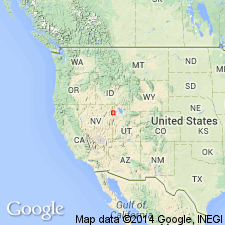
- Usage in publication:
-
- Shafter Formation*
- Modifications:
-
- Named
- Biostratigraphic dating
- Dominant lithology:
-
- Limestone
- Siltstone
- AAPG geologic province:
-
- Great Basin province
Summary:
Name derived from Shafter, site along Union Pacific Railroad, Shafter 7.5 min quad. Type section designated as 200-m-thick, thin-bedded, dark-gray silty limestone exposed one km west of Morgan Pass, sec 21, T32N, R68E, Morgan Pass 7.5 min quad, northern Goshute Mountains, Elko Co, NV. Is equivalent to unit D of Day and others (1987). Is present south of Silver Zone Pass in central Toano Range and in northern Goshute Mountains. Loser half of unit contains thin- to medium-bedded dark-gray aphanitic limestone. Upper half of unit is composed of medium-gray limestone and grayish-orange silty limestone to calcareous siltstone. Lower half of unit contains polymeroid trilobites and inarticulate brachiopods of upper BOLASPIDELLA and CEDARIA Assemblage Zones. Also contains elements of LEJOPYGE LAEVIGATA Assemblage Zone of Robison (1984). Underlies Goshute Limestone (new) in Morgan Pass area. In Toano Range, underlies Oasis Formation (new). In northern Goshute Mountains, underlies Lion Springs Limestone (new). Overlies Decoy Limestone. Age is considered Middle and Late Cambrian based on fauna.
Source: GNU records (USGS DDS-6; Denver GNULEX).
For more information, please contact Nancy Stamm, Geologic Names Committee Secretary.
Asterisk (*) indicates published by U.S. Geological Survey authors.
"No current usage" (†) implies that a name has been abandoned or has fallen into disuse. Former usage and, if known, replacement name given in parentheses ( ).
Slash (/) indicates name conflicts with nomenclatural guidelines (CSN, 1933; ACSN, 1961, 1970; NACSN, 1983, 2005, 2021). May be explained within brackets ([ ]).

